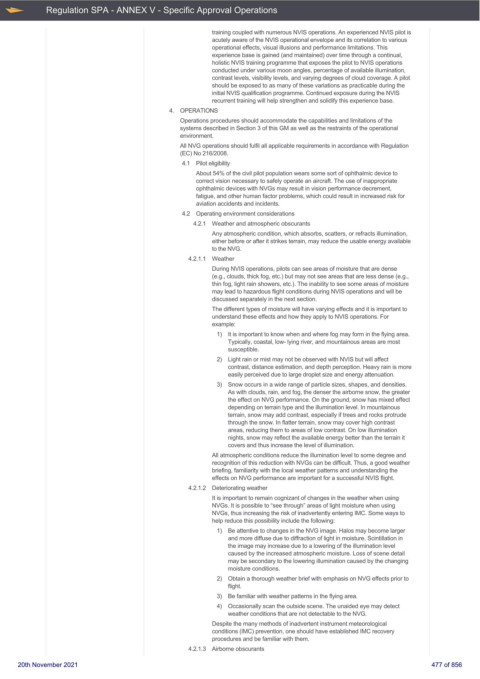Page 477 - UK Air Operations Regulations 201121
P. 477
~
~ Regulation SPA - ANNEX V - Specific Approval Operations Centrik
training coupled with numerous NVIS operations. An experienced NVIS pilot is
acutely aware of the NVIS operational envelope and its correlation to various
operational effects, visual illusions and performance limitations. This
experience base is gained (and maintained) over time through a continual,
holistic NVIS training programme that exposes the pilot to NVIS operations
conducted under various moon angles, percentage of available illumination,
contrast levels, visibility levels, and varying degrees of cloud coverage. A pilot
should be exposed to as many of these variations as practicable during the
initial NVIS qualification programme. Continued exposure during the NVIS
recurrent training will help strengthen and solidify this experience base.
4. OPERATIONS
Operations procedures should accommodate the capabilities and limitations of the
systems described in Section 3 of this GM as well as the restraints of the operational
environment.
All NVG operations should fulfil all applicable requirements in accordance with Regulation
(EC) No 216/2008.
4.1 Pilot eligibility
About 54% of the civil pilot population wears some sort of ophthalmic device to
correct vision necessary to safely operate an aircraft. The use of inappropriate
ophthalmic devices with NVGs may result in vision performance decrement,
fatigue, and other human factor problems, which could result in increased risk for
aviation accidents and incidents.
4.2 Operating environment considerations
4.2.1 Weather and atmospheric obscurants
Any atmospheric condition, which absorbs, scatters, or refracts illumination,
either before or after it strikes terrain, may reduce the usable energy available
to the NVG.
4.2.1.1 Weather
During NVIS operations, pilots can see areas of moisture that are dense
(e.g., clouds, thick fog, etc.) but may not see areas that are less dense (e.g.,
thin fog, light rain showers, etc.). The inability to see some areas of moisture
may lead to hazardous flight conditions during NVIS operations and will be
discussed separately in the next section.
The different types of moisture will have varying effects and it is important to
understand these effects and how they apply to NVIS operations. For
example:
1) It is important to know when and where fog may form in the flying area.
Typically, coastal, low- lying river, and mountainous areas are most
susceptible.
2) Light rain or mist may not be observed with NVIS but will affect
contrast, distance estimation, and depth perception. Heavy rain is more
easily perceived due to large droplet size and energy attenuation.
3) Snow occurs in a wide range of particle sizes, shapes, and densities.
As with clouds, rain, and fog, the denser the airborne snow, the greater
the effect on NVG performance. On the ground, snow has mixed effect
depending on terrain type and the illumination level. In mountainous
terrain, snow may add contrast, especially if trees and rocks protrude
through the snow. In flatter terrain, snow may cover high contrast
areas, reducing them to areas of low contrast. On low illumination
nights, snow may reflect the available energy better than the terrain it
covers and thus increase the level of illumination.
All atmospheric conditions reduce the illumination level to some degree and
recognition of this reduction with NVGs can be difficult. Thus, a good weather
briefing, familiarity with the local weather patterns and understanding the
effects on NVG performance are important for a successful NVIS flight.
4.2.1.2 Deteriorating weather
It is important to remain cognizant of changes in the weather when using
NVGs. It is possible to “see through” areas of light moisture when using
NVGs, thus increasing the risk of inadvertently entering IMC. Some ways to
help reduce this possibility include the following:
1) Be attentive to changes in the NVG image. Halos may become larger
and more diffuse due to diffraction of light in moisture. Scintillation in
the image may increase due to a lowering of the illumination level
caused by the increased atmospheric moisture. Loss of scene detail
may be secondary to the lowering illumination caused by the changing
moisture conditions.
2) Obtain a thorough weather brief with emphasis on NVG effects prior to
flight.
3) Be familiar with weather patterns in the flying area.
4) Occasionally scan the outside scene. The unaided eye may detect
weather conditions that are not detectable to the NVG.
Despite the many methods of inadvertent instrument meteorological
conditions (IMC) prevention, one should have established IMC recovery
procedures and be familiar with them.
4.2.1.3 Airborne obscurants
20th November 2021 477 of 856

